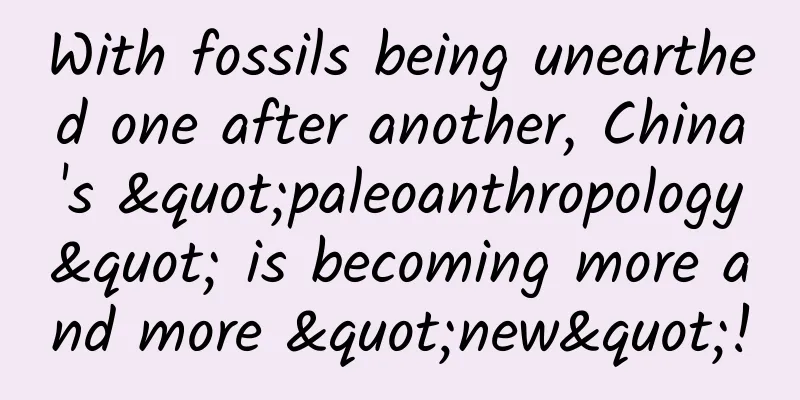With fossils being unearthed one after another, China's "paleoanthropology" is becoming more and more "new"!

|
In July 2024, the China Association for Science and Technology released the top ten scientific issues in China in 2024. Among them, the question "Are the ancient humans found in China the ancestors of modern Chinese people?" recommended by the Chinese Paleontological Society once again focuses our attention on the fascinating topic of human origins. What ancient human fossils have been unearthed in China? What issues has China's "paleoanthropology" been studying in recent years? 0 1 From Hetao people to Hualong Cave: A century of Chinese paleoanthropology In 1923, French missionary Sang Zhihua discovered a human tooth fossil on the boundless Hetao Plain. When he recorded the fossil, he unknowingly wrote the first chapter of Chinese paleoanthropology research - this tiny, seemingly inconspicuous incisor was the first human fossil unearthed in China . That year, museums around the world were already filled with precious ancient human fossils and stone tool specimens, and European and American naturalists were already trying to draw a perfect ending to the road map of human evolution. But who would have thought that before this French missionary, there had not even been a single human fossil unearthed by scientific excavation in the vast land of China. Today, China's paleoanthropology has undergone tremendous changes. Exactly one hundred years after the first Chinese hominin fossil was unearthed, Liu Wu and Wu Xiujie, researchers at the Institute of Vertebrate Paleontology and Paleoanthropology of the Chinese Academy of Sciences, announced their latest research results on the Hualong Cave hominin fossils. In this site hidden deep in the mountains of Anhui Province, the team of scientists discovered more than 30 hominin fossils, representing about 13 individuals. The number is so rich that it is rare in the world. In addition to Hualong Cave, the ancient human sites discovered in China in recent decades are already scattered all over the country. In the eyes of the public, these ancient human fossils may be fresh and interesting collections, but in the eyes of paleoanthropologists, they are evidence to solve historical mysteries. 02Is it necessary to update the knowledge in the textbooks? Many textbooks tell a straightforward story: A species of Australopithecus in Africa gave rise to Homo habilis , the earliest member of the genus Homo. Homo habilis gave rise to Homo erectus in Africa, which gave rise to Homo heidelbergensis , which gave rise to two lineages : One group was the Neanderthals , who were concentrated in Europe and the Near East and became an extinct branch; One of the descendants survived successfully, and we are modern humans . Australopithecus africanus fossil (Image source: Wikipedia) Reconstruction of a Neanderthal hunter (Image source: Wikipedia) As more and more Chinese fossils are unearthed, scientists around the world have come to realize that the story of human evolution is far more complicated than what is presented in textbooks. In the Hualongdong people, scientists have found complex mixed features - their faces are similar to those of modern humans, while their skulls retain a lot of primitive features , quite similar to those of ancient Homo erectus. The mandible shows primitive and advanced mosaic features, its overall morphology is similar to that of Homo erectus, and the shape of the joint is close to that of Neanderthals, with some features of the modern human chin, but lacking other features of the modern human chin. The characteristics of different ancient human lineages are also mixed in the Maba Man fossils. This is a skull fossil unearthed in Guangdong in 1958. In recent years, with the help of high-precision CT and 3D modeling technology, researcher Wu Xiujie has discovered new clues from the inside of the fossil. The brain of the Maba Man is relatively primitive, with the characteristics of Homo erectus and Heidelberg Man. But on such a primitive head, there is a more advanced "Neanderthal face". When we try to overlap the face of the Maba Man with the Neanderthal fossils unearthed in Italy, we will find that the two are highly similar, like twin brothers. There are many similar ancient human fossils in China, and their appearance seems to challenge the inherent cognition in books. Because these fossils have the characteristics of various branches, they cannot be clearly classified into the existing classifications of Homo erectus, Neanderthals, or modern humans . This points to a possibility that the branches of the human evolutionary tree are not as distinct as expected, but rather intertwined. In other words, perhaps the traditional classification system is problematic, or perhaps there is hybridization between the various branches of ancient humans. 03Mysterious unknown ancient humans are in China What is even more surprising is that there are some mysterious branches on the human evolutionary tree that have never been discovered. From 2007 to 2014, archaeologist Li Zanyang discovered ancient human skull fossils with peculiar shapes in Xuchang, Henan. This fossil shape is similar to the Neanderthals in Europe, but has an extremely large brain. Researchers Liu Wu and Wu Xiujie quickly linked the skull of the Xuchang man with the Xujiayao man unearthed in Hebei in the 1970s. The brain capacity of both reached an astonishing 1,700 ml or more. This is not only higher than all ancient humans of the same period, but also much higher than the average level of modern humans. Researcher Xing Song, also from the Chinese Academy of Sciences, also found that the tooth morphology of the Xujiayao man did not belong to any known ancient human. Therefore, Wu Xiujie and others believed that they might represent a branch that had never been recognized and called it " giant skull man ." However, many European and American paleoanthropologists speculate that the Xuchang people and the Xujiayao people may be the Denisovans they have been searching for for many years, another mysterious and unknown ancient human branch. In 2008, scientists extracted DNA fragments from a female finger bone fossil in the Denisova Cave in the Altai Mountains of Russia. The results showed that this prehistoric woman actually came from an unknown human species, named Denisovan. Ten years later, the Institute of Tibetan Plateau Research of the Chinese Academy of Sciences and Lanzhou University and other institutions conducted ancient protein testing on a human fossil unearthed in the Qinghai-Tibet Plateau and found that it was also a Denisovan. Denisovan finger bone and tooth fossils (Image source: Wikipedia) Despite this, only a few Denisovan fossils have been found worldwide, including a few limb bones, teeth, and mandibles. We still don't know what this mysterious ancient human looked like. Through ancient DNA testing, European and American scientists speculate that Denisovans looked similar to Neanderthals, but had a wider skull. Coincidentally, Xuchang Man and Xujiayao Man just meet this feature. Ancient DNA testing also shows that although the entities of Denisovans and Neanderthals have become extinct, some of their genes have not disappeared, but have been mixed into the genomes of modern East Asians through hybridization. In other words, we may still have the blood of these mysterious ancient humans flowing in our bodies. 04Where did the ancestors of the Chinese come from? Do we still have the blood of ancient human groups in China? In 2024, the China Association for Science and Technology released the top ten important scientific questions, one of which was "Are the ancient humans found in China the ancestors of modern Chinese?" Researcher Wu Xiujie was one of the people who proposed this question. According to the textbooks, ancient humans such as Peking Man are the direct ancestors of modern Chinese. There is a lot of evidence for this, such as their flat faces and shovel-shaped incisors, which appear in modern Chinese, while such features are rare in European and American people. Doesn't this seem like a kind of inheritance? However, according to the model deduction of the results of population DNA testing, all modern human ancestors came from Africa, and modern humans did not enter China until 60,000 years ago. In other words, the ancient humans in China went extinct and have nothing to do with contemporary Chinese. The timeline of the transition from the Paleolithic Age to the Neolithic Age, exhibited at the National Archaeological Museum of China (Photographed by Zhai Guoqing, the copyright of this image belongs to the photographer, authorized to use by the author, please indicate the source when reprinting) The results of the DNA study are not impeccable. Since 2011, researchers Liu Wu and Wu Xiujie have successively discovered a large number of ancient human tooth fossils in caves in Dao County, Hunan. At least from the teeth, these fossils dating back 120,000 to 80,000 years ago belong to completely modern humans. In addition, early modern human fossils dating back about 100,000 years have been found in Chongzuo, Guangxi and Huanglong Cave in Hubei. The human fossils found in northern China are still in the ancient stage, which means that modern humans may have appeared in China earlier than the 60,000 years ago estimated by the DNA model. Not only that, modern humans may have appeared in South China first, and then spread into North China. Although many fossils have been unearthed, the current number is still insufficient to clearly outline the fate of ancient Chinese humans. At the same time, since only a few fragments of DNA and protein are preserved in fossils, it is still difficult to directly extract genetic information from ancient human fossils. If we want to completely answer the question of the origin of modern Chinese people, I am afraid it is not possible at present. However, with the continuous emergence of ancient human fossils in China and even the entire East Asia, the day of solving the mystery of human origins should not be far away. Paleoanthropology is an ancient discipline that studies ancient times, but in the hands of Chinese scientists, this discipline is constantly bringing us new cognition at an astonishing speed. Author : Hui Jiaming, PhD candidate at the Sorbonne University, France, member of the Paris Anthropological Society Reviewer: Wu Xiujie, researcher at the Institute of Vertebrate Paleontology and Paleoanthropology, Chinese Academy of Sciences, director of the Chinese Society of Paleontology Produced by: Science Popularization China |
<<: How was Emperor Wen of Sui's favorite fruit transported from Sichuan to Shaanxi? | BoLan Daily
>>: The "Turtle Blind Box" controlled by Quan Hongchan actually has such great magic!
Recommend
How should SEM bidders deal with the setbacks they may encounter in their work?
As an SEM person, you will encounter various prob...
Moto X 3rd generation high-end version review: balanced and cost-effective flagship
Motorola Mobility, a subsidiary of Lenovo, today ...
Can Ping An continue to be “peaceful”?
Ping An's IPO price in Hong Kong in 2004 was ...
This kind of beans is perfect to eat in spring, but some people should eat it with caution
Ruan Guangfeng Broad beans are a kind of legumes ...
How to quantify and analyze the effectiveness of operational activities
I believe that for many analysts who are just sta...
How to sell goods through Douyin live streaming? 70 notes!
This is the information I collect on a daily basi...
Why do people laugh so hard that they can't close their mouths? The secret that makes people drop their jaws...
"Hahaha, I can't stop, I can't stop ...
【Smart Farmers】Looking at Field Crops from Space - Satellite Remote Sensing and Crop Mapping
In the news broadcast, we often hear such reports...
Mengmanren - Tutorial on making short videos of interesting facts animations on mobile phones, even beginners can do it
Mengmanren - Tutorial on making short videos of i...
How Pinduoduo improves user purchase conversion rate!
1. Definition of Purchase Conversion Rate Convers...
International Hydropower Association: 2021 Hydropower Status Report Industry Trends and Thoughts (Chinese Version)
The hydropower sector generated a record 4,370 TW...
What are the advantages for enterprises to carry out SEM marketing?
If companies want to get more and more accurate c...
Ningde Mini Program Production Company, how much does it cost to produce a kitchen mini program?
The factors affecting the quotation of Ningde Kit...
Wuchuan SEO Training: These methods may lead to excessive website SEO optimization, are you still using them?
Are there still many people using excessive websi...









